Some technological design I have been really fascinated with is The Tech Museum of Innovation in San Jose, California. They have created these experiences for the visitors where they are able to interact with the exhibits through wearable technology that allows them to create a meaningful connection to their surroundings. These wearable devices track the physical and emotional reactions of the visitors and at the end of their visit they are able to reflect on their experience. I’m a design student currently studying environments and these are the types of interactions we are currently exploring. I really admire this project because they were able to combine coding and design which lifts the interaction from the screen and puts it in the physical world, creating a unique experience each time. In the future, I would like to create more of these interactions to create more of a bridge between the digital and physical world.
Category: LookingOutwards-01
LO: My Inspiration
The project “Burger King” by Yixuan Cheng is something I admire because of the coherence and smoothness in the stop motion animation. Even though these are actual physical objects, she made them seem as if they are actually moving through her computational skills. The amount of time and effort put into this to make the illusion of motion through the cute characters she physically made is something I admire. Her meaning through this animation relayed the idea that Burger King is cheap, and she is showing this through the extreme actions of the burger onto the small creature. She created this project by using Adobe Illustrator and Dragonframe Stop Motion. Her works in illustration and animation could have been inspired by Tim Burton who is also a great artist that works with stop motion animation and illustration.
LO Inspiration
This artwork was created by Kyuha Shim and the piece is named “The Art of Selection” which is located on his website http://www.kyuhashim.com/.
I originally found this work because Kyuha was my professor last year and I heard he made amazing computational design. I specifically admire this project because it is such an engaging and beautiful animation. It is like an optical illusional but is also readable words when everything lines up perfectly. This makes the piece so respectable because it is a delicate balance that probably took Kyuha awhile to perfect.
I don’t know much about his work. However, Kyuha Shim is a designer who uses code and collects data. It seems like his focus isn’t on making custom software but rather using data. So I would assume he used commercial software to make his design.
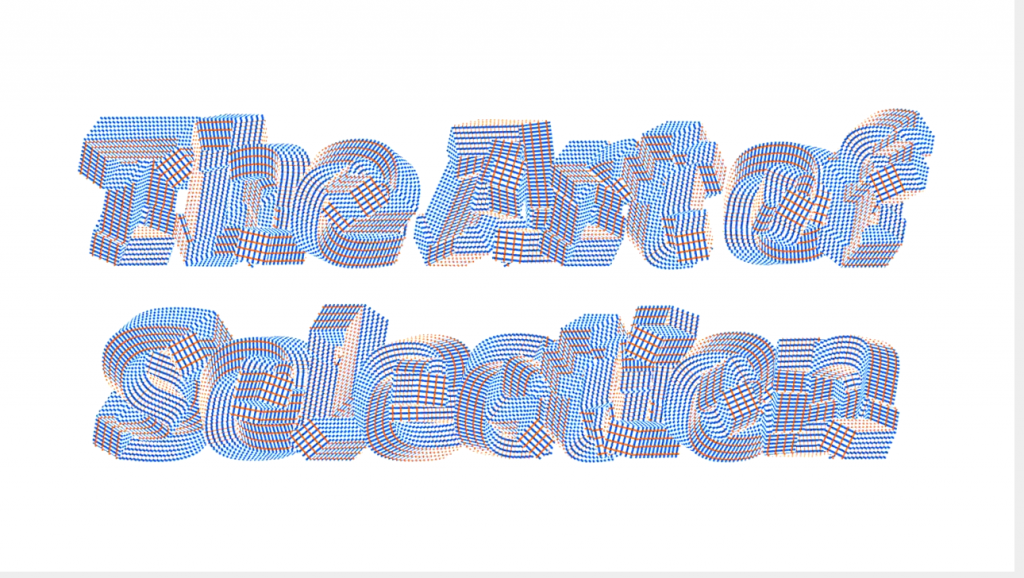
LO: My Inspiration
In cities across China, Local Projects (an experience design studio) has partnered with the soccer club Manchester United and Adidas to create a gaming experience for the fans. It is called the “Theatre of Dreams.” I found this project especially interesting because I am a huge soccer fan myself and the fact that there is an experience that they created that allows the fans to become football players them. Furthermore, it appeals to the emotions of the fans as it takes into account the rich history of the Club as well. They try and capture the emotions and atmosphere of an actual match day event and the energy of the stadium as if the users were in it. The creators of this experience, Local Projects, seemed to have created the software for this immersive experience by themselves. As far as I know, this is an experience like none other and it takes inspiration from the fact that fans make their intense love for the game well known. This breakthrough experience that they have created can probably inspire other clubs to provide similar experiences as each club has their own unique history and spirit. Here is the link for the immersive experience.
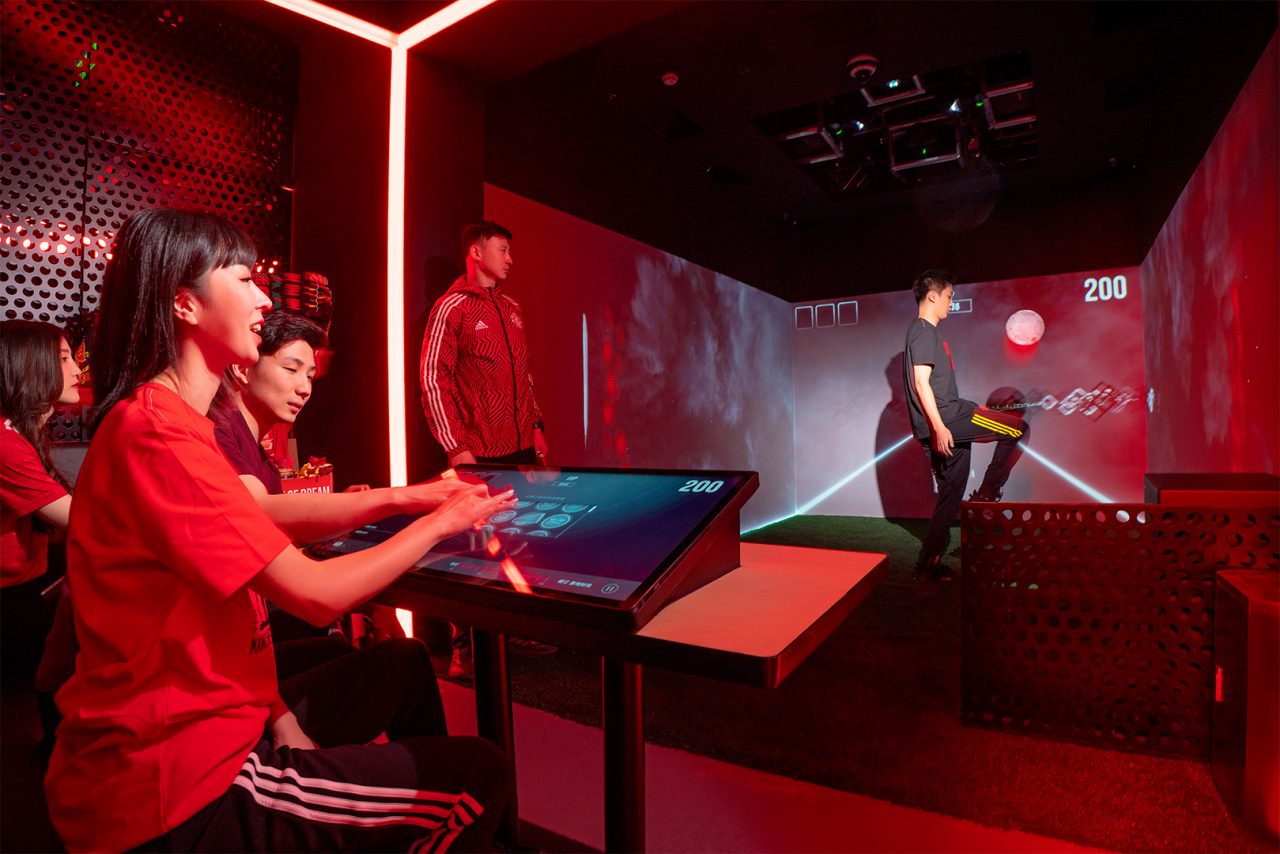
LO: My Inspiration
One of my favorite interaction and computational projects is the BioDesign Studio in the Tech Museum of Innovation created by Local Projects. Local Projects is a group of designers and creative technologists who aim to change how people interact with environments and with each other. This project educates people about synthetic biology, in which visitors can connect different DNA models together and a screen will display the lifeforms being created. I admire this project because the design and engineering team was able to create a seamless interaction between the tangible and the digital world. I like how the interaction is not limited to a screen, so social interaction is also made possible. I personally think the project points to the future of museum exhibitions and maybe even education, as learning through an interactive experience could benefit many people.
Author & Title: Local Projects, BioDesign Studio – THE TECH MUSEUM OF INNOVATION.
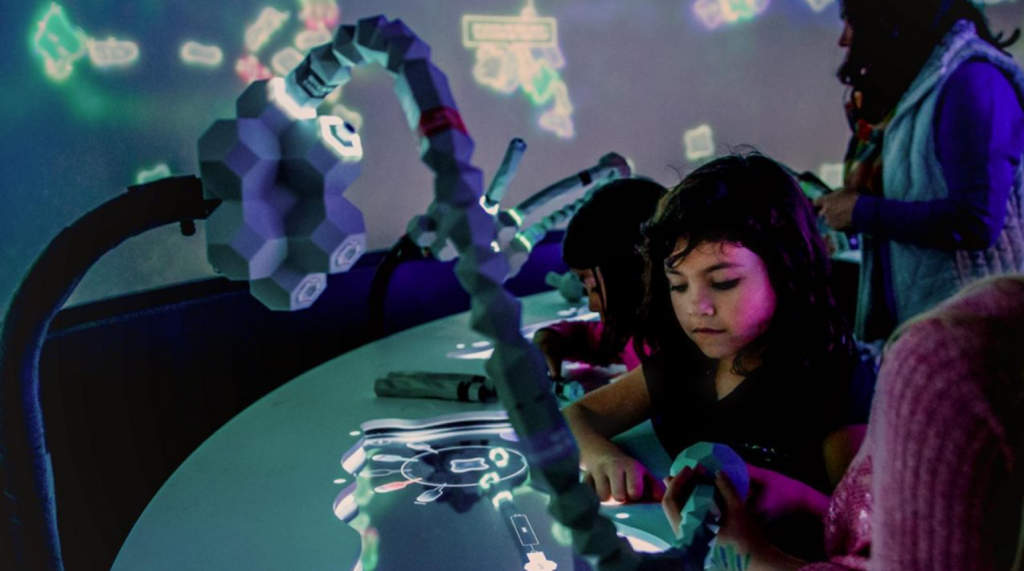
LO: My Inspiration
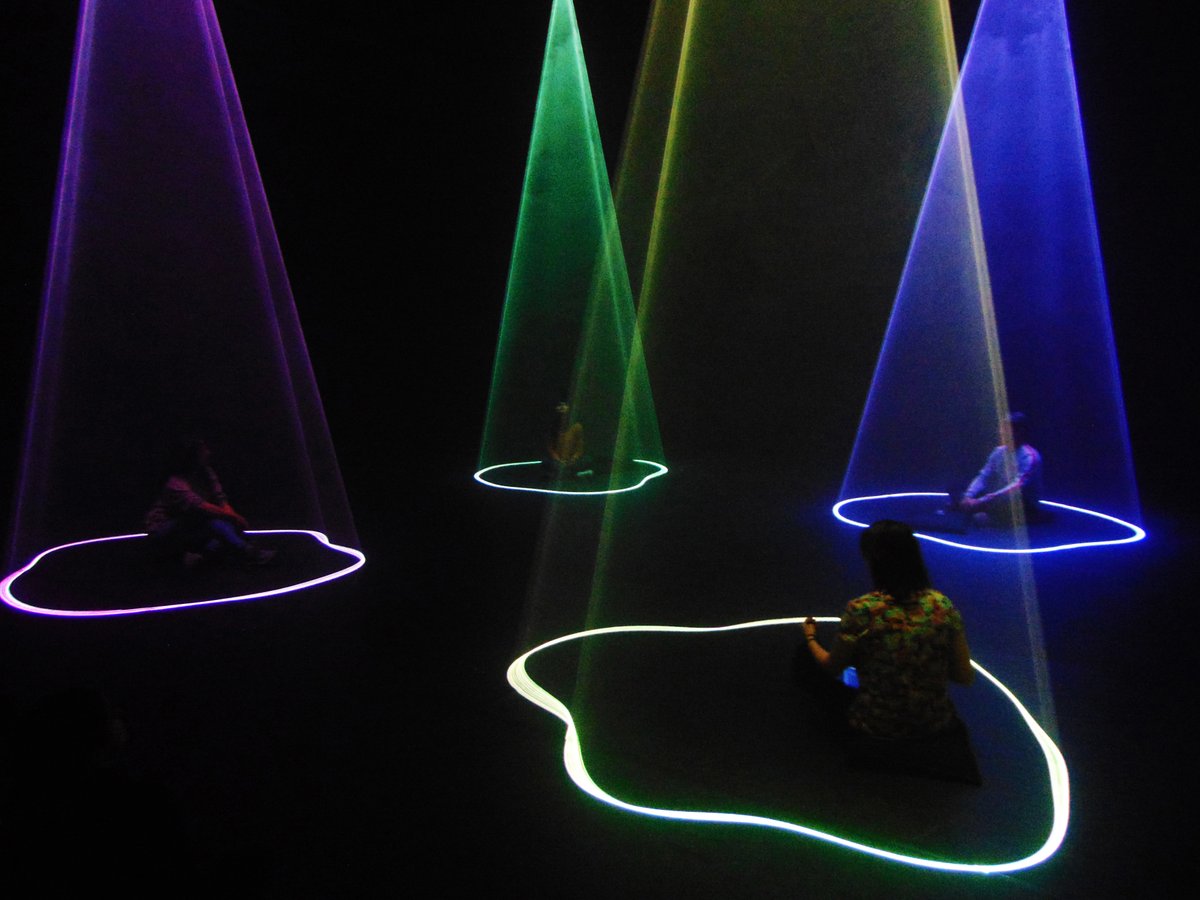
Title: Aura
Creator: Nick Verstand, Salvador Breed, Naivi
Link: https://www.dezeen.com/2017/11/25/aura-installation-translates-emotions-into-beams-of-light-studio-nick-verstand-dutch-design-week/
During 2017’s Dutch Design Week, artist Nick Verstand created an immersive audiovisual installation named Aura that translated visitors’ emotions into light pulses. I’m inspired by this project as it makes the visitors part of the art. As visitors entered the space, music was played to evoke emotional responses. Physiological signals including EEG, heart-rate, and galvanic skin response were then recorded by the various biosensors visitors wore and later used to generate light beams with different forms, colors and intensities surrounding the visitors like curtains.
The project aimed to explore the use of light as art medium and paid tribute to artist Anthony McCall. It’s is unclear how long the project took. But it likely required the three artists to write custom scripts as they needed to translate signals from biosensors to light output. This work shows how technology can externalize and recreate the experience of human emotions.
LO: My Inspiration Satterwhite
When I first arrived back in Pittsburgh, one of my friends who is an RA told me to go see the Jacolby Satterwhite exhibition at the Miller ICA. I thought it was incredible how he did this with just so few other contributors. Jacolby was influenced by his mother and black culture among many of his other interests. He was able to use pop culture, history, holistics, and his personal experience. His exhibit has sculpture work and photography, but also uses 3D animation, VR, LED, and sound. Jacolby developed a multiform gestalt to create his VR. When walking through the exhibit, other than the lighting, it was very much like walking through a normal museum. Once I put on the VR set everything changed. It is hard to explain but it was easy to be immersed in the imagery and actions. Using the technology in a way that made it encompass my senses (sight and hearing), allowed me to pay attention. It was something I had never experienced before and I think it really goes to show how much the world is changing to hold people’s interests.
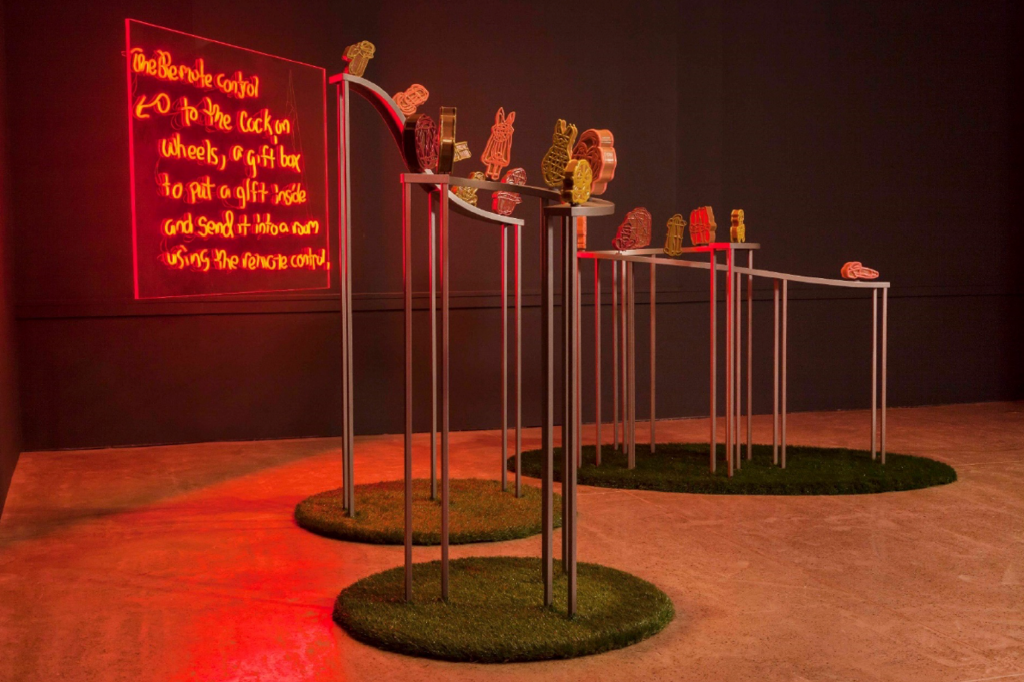
LO: Inspiration
Mi.Mu Gloves by Imogen Heap
This project is a set of gloves developed by the musician Imogen Heap that allow her to interact gesturally with her music production software on her computer. The gloves are primarily an interesting piece of hardware, however computation was certainly involved in the process of translating sensor inputs into musical outputs. I think this project is a really interesting way to explore gesture in electronic music, a genre that is typically produced through a very limited set of gestures like turning knobs, and pressing buttons. I think this project is particularly interesting for both its potential to open up new ways of creating music, and the possibility to link performative gestures such as dance to sonic experiences.
LO: My Inspiration
In Sun Yuan and Peng Yu’s “Can’t Help Myself,” which was an installation at the Guggenheim, a robotic arm restlessly tries to clean up red liquid on the floor, to no avail. The robot knows 32 different movements. It is trapped within a transparent “cage,” where the viscous liquid continuously triggers the robot’s sensors to shovel and scrape. The resulting, never-ending, blood-like splatters evoke violence at border zones and the consequences of authoritarianism; as the Guggenheim states. The real meaning is up to interpretation.
I really admire the uniqueness of this piece. Typically, when someone creates an AI, it is for a specific purpose; to have self-driving cars, to mimic human capabilities, to push the limits of what AI can do. I appreciate that “Can’t Help Myself” is purely an artistic work. With so many different movements as it frantically scrapes, it almost looks like a panicked choreography.

LO: My Inspiration

I truly enjoy and admire the work of TeamLab. TeamLab is an international art collective that creates interactive artworks using digital projections, pulling together artists, programmers, engineers, CG animators, mathematicians, and architects for their projects. In particular, I love their exhibit TeamLab Planets Tokyo. In this exhibit, flowers, water, lava, light structures, and other wild features are projected upon simple constructions to immerse the participants. It is clearly inspired by our natural planet and seeks to show every person a different perspective on existing in nature. As stated on TeamLab’s website, this seeks to dissolve the “boundary between the body and the artwork” and “explore a new relationship without boundaries between ourselves and the world”. As our personal worlds become more digitised, a generated interaction between the user and nature, like TeamLab Planets Tokyo, prompts an interesting discussion about how much of natural experience we can imitate.
![[OLD SEMESTER] 15-104 • Introduction to Computing for Creative Practice](../../wp-content/uploads/2023/09/stop-banner.png)